The Preussen class were three ironclad turret ships initiated by the Prussian Navy, and completed for the German Imperial Navy in the 1870s as it happened after Franco-Prussian war, and unification into the German Empire. The lead ship, Preussen and Friedrich der Grosse were both laid down in 1871 but Grosser Kurfürst, was actually the first laid down in 1869, and last completed. They served in the same squadron, but Grosser Kurfürst was lost in 1878 during manoeuvres due to a collision with her sister. Preussen and Friedrich der Grosse from the late 1890s were relegated to secondary duties, harbour defence ships, and coal hulks as the first world war came out, renamed. They were sold for scrap in 1919 and 1920. #prussiannavy #germanynavy #kaiserlichesmarine #prussen #grosserkurfurst #ironclad
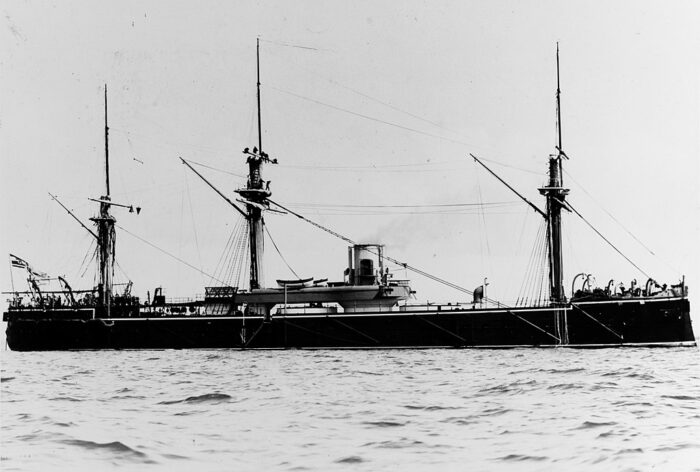
Development
In 1867, the ex-Prussian, now “North German Reichstag” approved a fleet plan calling for its largest extension yet, no less than sixteen ironclads and many cruisers and avisos. The plan was to be completed by 1877. The ironclad fleet was still for coastal defence and prevent blockade of German ports, such as the one orchestrated by the Danish Navy in the Second Schleswig War of 1864. The Prussian Navy in 1867 possessed the small ironclads Arminius and Prinz Adalbert and had been ordering to Britain and France larger ironclad frigates, SMS Friedrich Carl, Kronprinz, and König Wilhelm. In 1868 the first German-built Corvette Ironclad, called SMS Hansa, was laid down, followed by the Preussen class, the first uniform class and turret ships in the fleet, the latest trend.
Design for the Preussen class was prepared in 1868 by the newly formed Admiralitätsrat (Admiralty Council) under chief designer Carl Elbertzhagen. The idea was to create a casemate ship modelled on the Austro-Hungarian ironclad Custoza. The latter was a massive, 7800 tonnes central battery ironclad with broadside arrangement and few, very large-caliber guns in superposed casemate amidships, with corner guns on rails for better arc of fire. The first to be so designed was SMS Grosser Kurfürst, laid down based on this design.
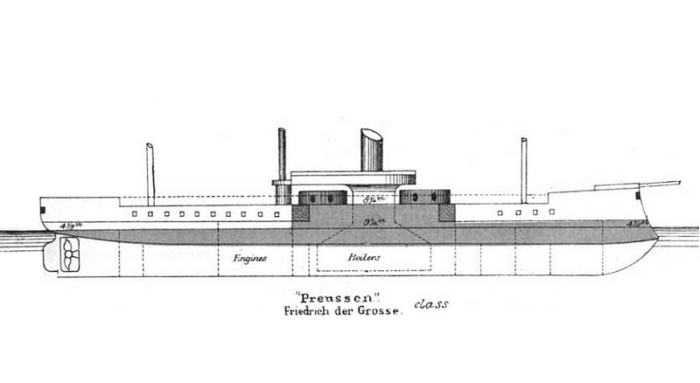
But in 1869, Carl Elbertzhagen was asked to look at Britain, that started to marry the new Coles design Turret with first rank ships. The turret seemed to offer a completely new set of advantages. So after consulting the Admiralitätsrat and government, he redrafted the plan to make a turret ship, with two revolving twin-gun turrets of similar pattern as the one from Cowper Coles, in a lower axis position. In fact, the ship that was looked upon was the brand-new British ironclad HMS Monarch. The heavy turrets needed to be mounted low to keep the center of gravity and metacentric height.
The new ships would have low freeboards and that impacted sea keeping, so a built-up forecastle and stern castle with hinged bulwarks along the lower sides were the only solution while underway. It was understood that these vessels were for the Baltic and for local coastal defence. But this was a completely new design, with only the keel up to the waterline, machinery, and ram staying. The reworking of all plans and revision of internal spaced caused massive delays in construction for Grosser Kurfürst, which parts had to be retired and rebuilt. The other two, Preussen and Friedrich der Grosse were actually laid down in 1871, just as the new German Empire was constituted.
Design of the class
Hull and general design
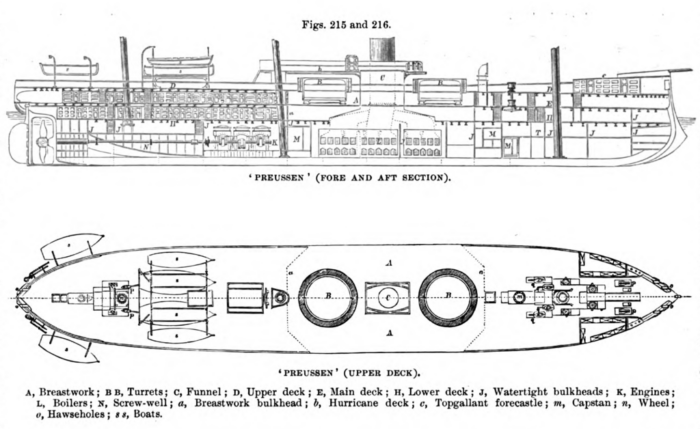
The Preussen class were among the largest ironclads in Germany so far at 94.50 m (310 ft) long (waterline), 96.59 meters (316 ft 11 in) overall for a beam of 16.30 m (53 ft 6 in) and draft of 7.12 m (23 ft 4 in) forward, 7.18 m (23 ft 7 in) aft. Final displacement was 6,821 metric tons (6,713 long tons), there was no such things as standards at the time. If fully loaded, displacement then rose to 7,718 t (7,596 long tons).
Construction called for transverse and longitudinal iron frames with cover made of iron plating backup by teak wood for flexibility as frequently done at the time. The underwater protection comprised twelve watertight compartments with bulkheads and double bottom covering 60% of the hull length.
The general design due to the three masts and full rigging is limited to a structure around the single main funnel, overhanging the turrets. This platform is occupied by the wooden-panelled bridge, and later in 1880 by light guns.
Powerplant
The three ships had the same machinery, a single shaft, four-bladed propeller 6.60 m (21 ft 8 in) diameter, 3-cylinder single expansion engine. Preussen’s engine was manufactured on the same plans by AG Vulcan, whereas SMS Friedrich der Grosse and Grosser Kurfürst had their engine provided by F A Egells of Berlin. Steam came from six coal-fired transverse trunk boilers. They were all provided by the Imperial Dockyard in Wilhelmshaven. These boilers were trunked into a single and large funnel amidships which was also retractable to make sailing easier. In use, the main stay of the middle mast was folded up.
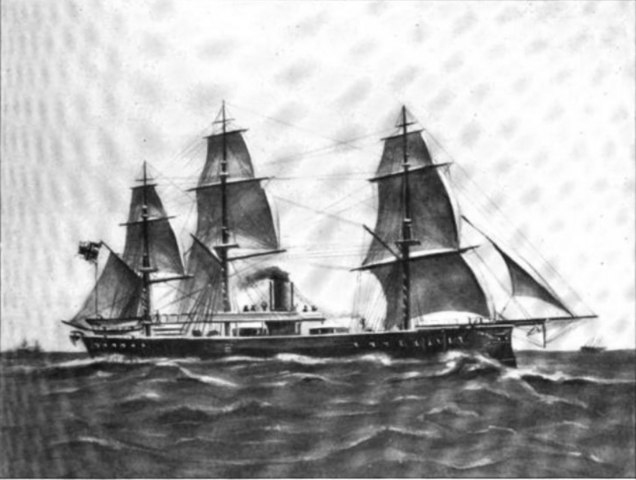
Since this class had been planned in the 1860s, full ship rig was mandatory. The three masts were rigged as a barque, with three stage, up to four sails square on the first two masts, as spanker and three jibs.
Electric power aboard consisted in three generators capable of 30 kilowatts of electrical power, they were among the first ironclads in the worlds to be electrically powered at all times. This machinery provided a top speed of 14 knots (26 km/h; 16 mph) from 5,471 metric horsepower (5,396 ihp). For range, they carried 564 t (555 long tons; 622 short tons) of coal enabling to cover 1,690 nautical miles (3,130 km; 1,940 mi) at 10 knots (19 km/h; 12 mph) and they used sails for longer crossings. They were generally regarded as good sea boats and were very sensitive from the helm, with a gentle rolling motion. And despite of the ram, they had a tight turning radius. However, under sail they were crank and slow.
Protection

The Preussen’s class armor was made of wrought iron, backed with teak.
The armored belt had two strakes, the upper in wrought iron plating 203 mm (8.0 in) and a lower strake also of iron between 102 to 229 mm (4.0 to 9.0 in), both backed respectively of 234 to 260 mm (9.2 to 10.2 in) teak. This made for an ideally flexible four-layer sandwich, the upper one providing the bulk of stopping incoming rounds, and the internal one to stop shrapnel and shards. Plus there was a thick pain coating and spall liner internally.
The Preussen class had a forward conning tower covered with 30 mm (1.2 in) walls, and 50 mm (2.0 in) slopes.
The gun turrets were protected by 25 mm (0.98 in) roofs with curved sides that were 203 up to 254 mm (8 to 10 inches) in thickness. These were backed with 260 mm (10 in) thick teak, like for the belt. The turrets were thicker at the front, sides and rear being tapered down.
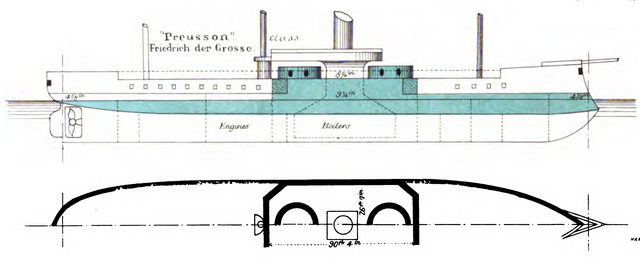
In Brasseys naval annual 1887
Armament
The Preussen class were designed in 1867-68 with four 26 cm RK L/22 guns (10.2 in) but in between it was reported that shallower grooves for rifling provided better accuracy, these guns barrels were bored up and rose to 26.3-centimeter (10.4 in). Instead of being placed in echelon they were in the axis, keeping the beam narrow, but the aft turret could not fire forward and vice versa, but this was consistent with the Prussian tactics of the day relying on the battle line.
The fore and sterncastles needed protection for the axis dead angle, and so two 17 cm (6.7 in) RK L/25 chase guns at each end were placed, shielded.
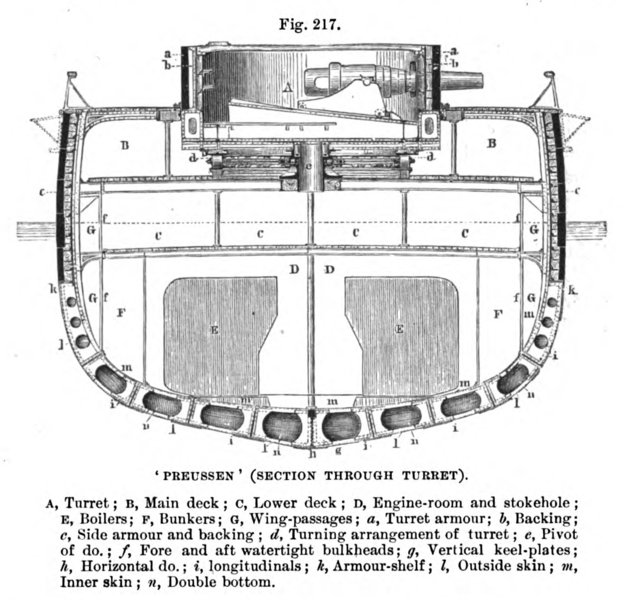
26 cm RK L/22 guns
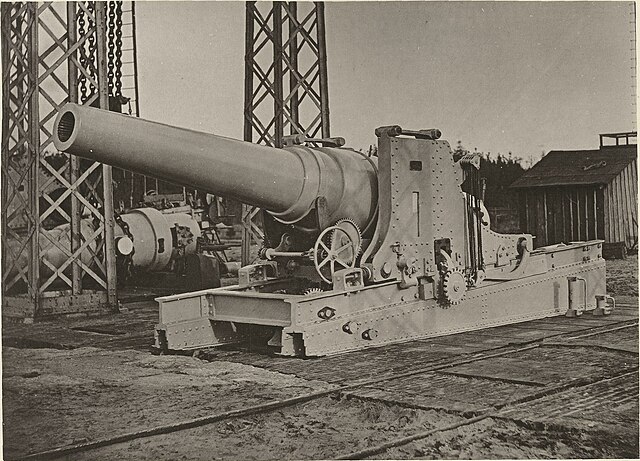
They were mounted in both steam-powered twin-gun turrets placed amidships on the battery deck and 400 rounds were carried, all AP by default. These guns could depress to −3° and elevate to 11° for a maximum range of 5,000 m (5,500 yd). These guns were brand new when installed, designed for the Preussen class but also largely exported. Mass: 22 tonnes, 5,720 mm (L/22) barrel 262.5 mm exact caliber, horizontal sliding wedge breech, muzzle velocity 490 m/s.
17 cm (6.7 in) RK L/25 chase guns
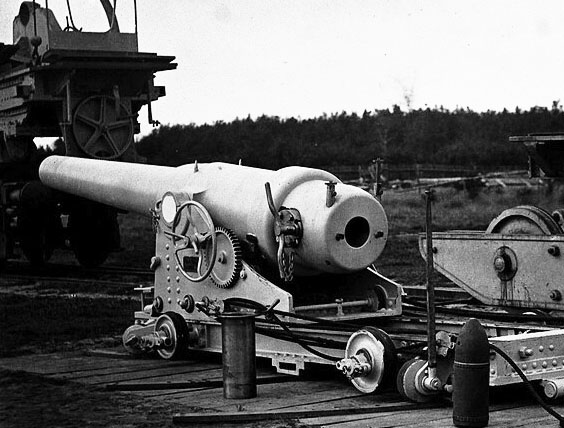
The Krupp L/25 weighted 5,600 kg for a length of 4.250 m, exact caliber 172.6 mm and muzzle velocity of 524 m/s. 200 rounds of ammunition supplied for these, and they could elevate to 11° max, for a 5,000 m range, like the main guns.
Upgrades (1889-91)
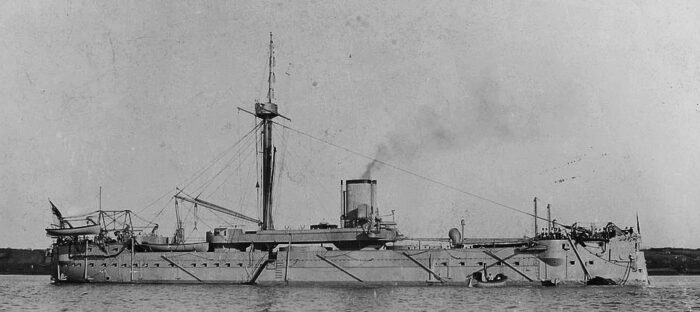
SMS Preussen in 1884, photo by Arthur Renard in Kiel
Between 1889 and 1891, Preussen and Friedrich der Grosse, the only ones surviving, were rebuilt. They had new boilers installed as well as a reconstructed poop deck. Their sailing rig was also reduced. Eventually they received ten 8.8 cm (3.5 in) SK L/30 quick-firing guns to protect against torpedo boats, with a total of 2,500 rounds in store. Two 37 mm auto-cannons were also added (likely Nordenfelt) and five 35 cm (14 in) torpedo tubes underwater in the hull for SMS Preussen, and above water for SMS Friedrich der Grosse and a total of 13 torpedoes were provided, of the Schwartzkopff type.
The 1873 model weighted 616 pounds for 14 feet, 9 inches long, 14 inches diameter, and effective firing range of 220-440 yards (200-400 m) and carrying a 44 pounds guncotton warhead with contact fuse at 22–25 knots, in straight course guided by depth control and gyroscope.
Construction
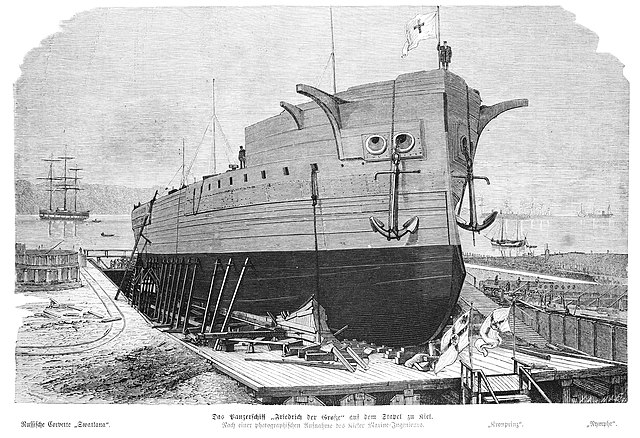
The process was extremely lengthy and given the fast pace of technological innovation at the time, the last ship, Friedrich der Grosse was already obsolete at completion. Indeed, design went back to 1867, approved in 1868, laying down of the first in 1869, with a gap for the other two members of the class in 1871. The problem was that the newly established imperial shipyards in Kiel were inexperienced. Kaiserliche Werft in Wilhelmshaven had more experience, but still, these were the first turreted ironclads of the German Navy. Preussen was the only one to be built at the more experienced, private AG Vulcan shipyard in Stettin. Grosser Kurfürst was completed last due to post start redesigns, and mostly due to the yard’s inexperience making for a total of ten years, eight for her sisters Friedrich der Grosse and six for Preussen, which came from Vulcan. Many manufacturing issues also had to be corrected later.
Their career was a bit strange. Preussen post commissioning in July 1876 joined the Mediterranean squadron due to the ongoing Russo-Turkish War, with German citizens at risk. It was commanded by Rear Admiral Carl Ferdinand Batsch, stopping at Haifa and Jaffa and cruising the Med, showing the flag until back home in October. In May 1878, all three took part in the summer manoeuvres, with König Wilhelm, still under Batsch but Friedrich der Grosse ran aground off Nyborg and the three Prussen, while in the English Channel on 31 May, saw König Wilhelm ramming Grosser Kurfürst, and given the rams they had at the time, flooding was unstoppable, and she sank with the loss of 269-284 men depending on sources. A tragedy, which in addition left a single operating ship in the class and for the whole squadron as König Wilhelm also needed repairs. Investigations into the circumstances led to the acquittal of Batsch and captain Count Alexander von Monts but there was political infighting and Rear Admiral Reinhold von Werner was eventually dismissed.
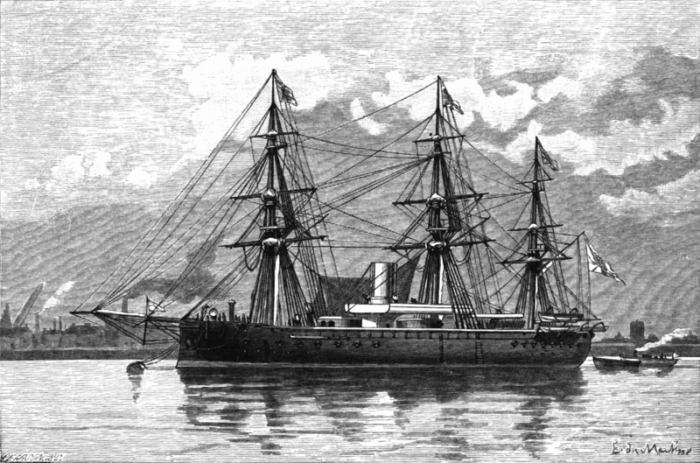
In Brasseys 1882
Preussen and Friedrich der Grosse started a cycle of training cruises starting until 1883, placed into reserve shortly after their reconstruction, and made irrelevant with the arrival of the four Sachsen-class ironclads. They were reactivated in 1889 for a special coronation review for Kaiser Wilhelm II, including a trip to Great Britain in August 1889 and Mediterranean winter cruise in 1889–1890. There were rarer and short training cycles with Preussen recommissioned in 1891, Friedrich der Grosse in 1894. The still valuable hulls took secondary roles (harbor ships, coal hulks) and sold for scrap after WWI, BU in 1920 and thus, seeing the rise and fall of the German Empire.
There were plans in 1900 to modernize again the two battleships and the navy staff considered converting them as armored cruisers along similar lines to the Kaiser-class ironclads in order to relieve SMS Kaiser in East Asian waters, but this was never voted.
⚙ Preussen specifications |
|
| Displacement | 6,821 t (6,713 long tons) standard, 7,718 t (7,596 long tons) FL |
| Dimensions | 96.59 x 16.30 x 7.11 m (316 ft 11 in x 53 ft 6 in x 23 ft 4 in) |
| Propulsion | 1 shaft, Single-expansion TE, 6 boilers: 5,471 PS (5,396 ihp) |
| Speed | 14 knots (26 km/h; 16 mph) |
| Range | 1,690 nmi (3,130 km) at 10 kn (19 km/h) |
| Armament | 4 × 26 cm (10 in), 2 × 17 cm (6.7 in) guns |
| Protection | Upper belt 203 mm (8 in), Lower belt: 102-229 mm (4 to 9 in), turrets 203 to 254 mm (8 to 10 in) |
| Crew | 46 officers+ 454 enlisted men |
Career of the Peussen class
 SMS Grosser Kurfürst
SMS Grosser Kurfürst
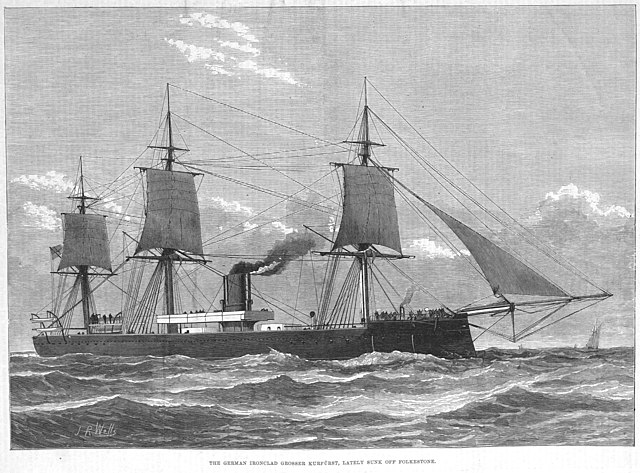
Grosser Kurfürst was laid down at Kaiserliche Werft in Wilhelmshaven by 1869 (date unknown) and launched on 17 September 1875, completed and commissioned on 6 May 1878, the named meant “Great Elector”. Erich Gröner states 1869 but Hans Hildebrand, Albert Röhr, Hans-Otto Steinmetz not agree as construction work on the newly built Kaiserliche Werft was still ongoing by December 1869 and the Franco-Prussian War only will end by July 1870, so potentially against collecting building materials. CiC General Albrecht von Stosch christened her on behalf of Peter II, Grand Duke of Oldenburg. She started sea trials by December 1877 and was formally commissioned of 6 May 1878 with still shipyard workers aboard. First under Kapitän zur See Alexander von Monts she followed the armoured squadron in April 1878, when reactivated for the summer training under Konteradmiral Carl Ferdinand Batsch.
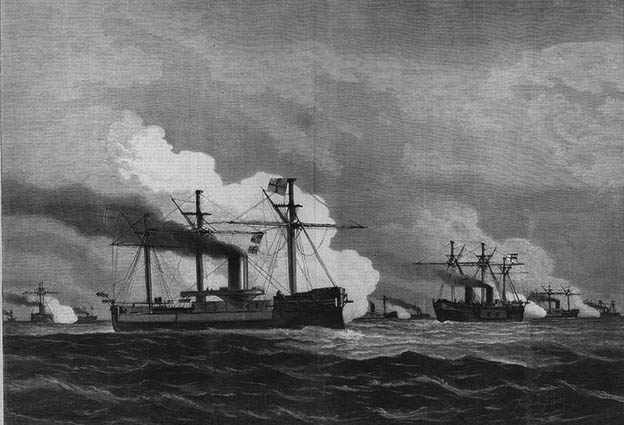
In addition to her sister Preussen, Friedrich der Grosse, König Wilhelm were preceded by the aviso Falke from 6 May and Grosser Kurfürst joined them on 27 May, albeit the crew was still not ready for major operation. Friedrich der Grösse grounded in between, resulted in serious damage and repairs. On 29 May all three sailed for the Mediterranean, without Falke which went back home due to engine problems. While in the North Sea, Grosser Kurfürst stick her rudder, but it was freed while underway and her inexperienced crew had a hard time keeping station with the others, partly due to poor coal. Pressure was low and she fell behind. König Wilhelm was on the left column, followed by Preussen. Grosser Kurfürst was on the right by herself and at 02:55 on 31 May, they entered the English Channel, taking a single file formation, then again, two column, with Grosser Kurfürst 400 m (1,300 ft) way from the others passing the Goodwin Sands at 07:40, and entered afterwards the Strait of Dover.
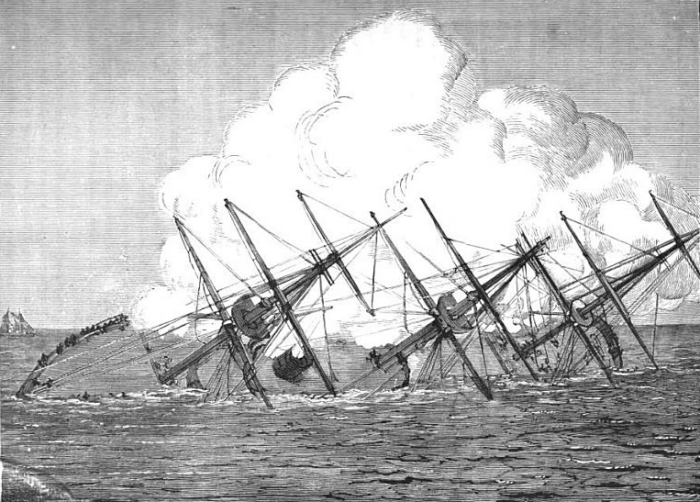
SMS Grosser Kurfürst sinking on her maiden voyage
Batsch ordered by flags Grosser Kurfürst to close 100 m (330 ft) to them due to the narrows and Monts took direct command of the helm. They passed the narrowest point at 09:00 at 9 knots, passed Folkestone, crossed a barque and brig on a southeast course 600 m from them and due to maritime regulations, König Wilhelm and Preussen turned to starboard, to avoid a potential collision, Grosser Kurfürst following the manoeuvre, but she became dangerously close to König Wilhelm. Monts ordered full power, turned hard to starboard, Batsch on his side ordered König Wilhelm hard to port bu they were carried by inertia and König Wilhelm ram bow tore a large hole in Grosser Kurfürst’s flank, with immediate flooding. Grosser Kurfürst was pushed back to port by the shock, her mizzenmast falling and upper works damaged, and she lost her port boats.
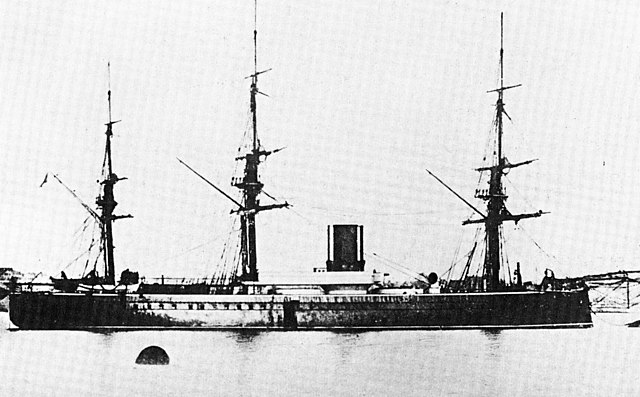
König Wilhelm disentangled, slowly returned to her original course and limited flooding due to the shock was quickly brought under control. Not aboard Grosser Kurfürst. The ram struck just at one of her transverse watertight bulkhead, mushed, feeling compartments on both sides and due to crew error her other bulkheads were not adequately sealed. Her list increased to the point water entered portholes and later hatches. Monts tried to steer to beach her, but she was just too heavy and slow, lost her power, and after just 1.5 nautical miles (2.8 km; 1.7 mi) she capsized and sank. Hopefully 15 minutes after the collision Monts ordered to abandon ship and so part of the crew escape (diverging fatalities between sources here, total still varied between 269 and 276 or even 284).
König Wilhelm approached, lowered her boats, Preussen stopped some 800 m away, and nearby British fishing boats and others joined the rescue, picking 60 men. Monts was picked up by a boat from König Wilhelm, which capsized due to overcrowding. The scene was depicted for newspapers by Arthur Sullivan, on his way to Paris. König Wilhelm was still badly damaged, and her captain initially intended to beach her, but the pumps could held so she proceeded ti Portsmouth for temporary repairs and she went back home. A court martial was held for the squadron commander Batsch, Captains Monts and Kuehne, and Lieutenant Clausa (XO Grosser Kurfürst) for investigation hearings.
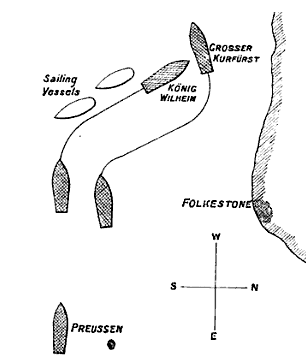 The court of Inquiry was chaired by Konteradmiral Reinhold von Werner. Monts defended himself by stating her reported his crew was still untrained for that sortie after 3 weeks instead of the 4-6 weeks he asked for and about all the dockyard workers still finishing work. The enquiry decided Batsch was at fault to oversee the König Wilhelm’s manoeuvre and exonerated Monts. Stosch tried to protect Batsch and was eventually blamed in turn by Kaiser Wilhelm I. Eventually he launched a campaign to blame Werner and managed to gain his ouster on 15 October 1878. The second court-martial found Batsch guilty, a third in January 1879, reversed it and convicted Monts and the watch officer of negligence with short prison terms, not sanctioned by the Kaiser.
The court of Inquiry was chaired by Konteradmiral Reinhold von Werner. Monts defended himself by stating her reported his crew was still untrained for that sortie after 3 weeks instead of the 4-6 weeks he asked for and about all the dockyard workers still finishing work. The enquiry decided Batsch was at fault to oversee the König Wilhelm’s manoeuvre and exonerated Monts. Stosch tried to protect Batsch and was eventually blamed in turn by Kaiser Wilhelm I. Eventually he launched a campaign to blame Werner and managed to gain his ouster on 15 October 1878. The second court-martial found Batsch guilty, a third in January 1879, reversed it and convicted Monts and the watch officer of negligence with short prison terms, not sanctioned by the Kaiser.
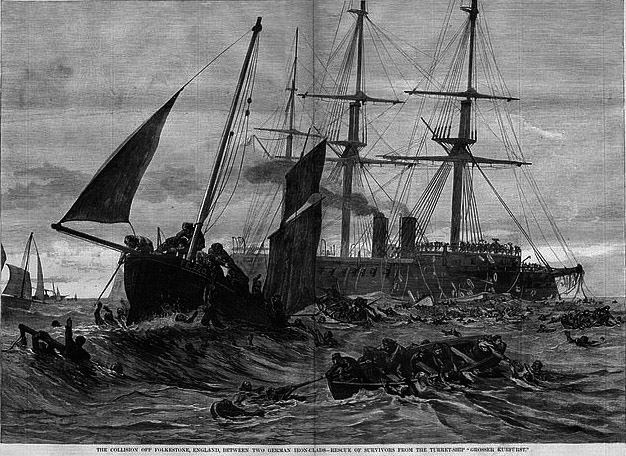
The rescue at Folkestone 1878
Batsch however was sentenced six months in prison, suspended after two months. Stosch requested another court-martial for Monts, failed and submitted his resignation. Lessons were drawn from this, and efficient, minimal training was now made mandatory. But these series of trials left the command structure weakened. Stosch came from the army and was wildly criticized for rushing out the ironclad into service “in a few days like a regiment or a brigade”. The German Reichstag was also more reluctant to order more ships in the future, in fact for most of the 1880s. There is a commemorative stone at Folkestone since 1881 and a modern survey of the wreck by divers. There were three salvage propositions and by 2020, “Historic England” announced the memorial would be listed as a Grade II, prohibiting salvage or removal of artefacts.
 SMS Preussen
SMS Preussen
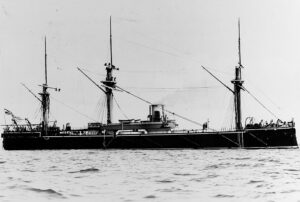 SMS Preussen was laid down at AG Vulcan in Stettin well after their sister in 1871, launched on 22 November 1873 and completed on 4 July 1876. Sea trials commenced on 16 November, but she needed her hull to be strengthened hull to break ice in the Baltic until 2 March 1877, and she resumed trials until 5 May. In the squadron she replaced the ironclad Kronprinz in overhaul, led by flagship Kaiser, sent for the Mediterranean on 30 May due to unrest in the Ottoman Empire (Russo-Turkish War). She departed also with the ironclad Deutschland, Friedrich Carl, aviso Falke under Konteradmiral Carl Ferdinand Batsch. After tensions abated, they were back in October. She stopped underway in La Goulette, French Tunisia, but was later badly damaged by severe weather and dry-docked for repairs in Germany.
SMS Preussen was laid down at AG Vulcan in Stettin well after their sister in 1871, launched on 22 November 1873 and completed on 4 July 1876. Sea trials commenced on 16 November, but she needed her hull to be strengthened hull to break ice in the Baltic until 2 March 1877, and she resumed trials until 5 May. In the squadron she replaced the ironclad Kronprinz in overhaul, led by flagship Kaiser, sent for the Mediterranean on 30 May due to unrest in the Ottoman Empire (Russo-Turkish War). She departed also with the ironclad Deutschland, Friedrich Carl, aviso Falke under Konteradmiral Carl Ferdinand Batsch. After tensions abated, they were back in October. She stopped underway in La Goulette, French Tunisia, but was later badly damaged by severe weather and dry-docked for repairs in Germany.
In April 1878 she took part in fleet manoeuvres under Batsch’s command joined by her sisters Friedrich der Grosse and Grosser Kurfürst.
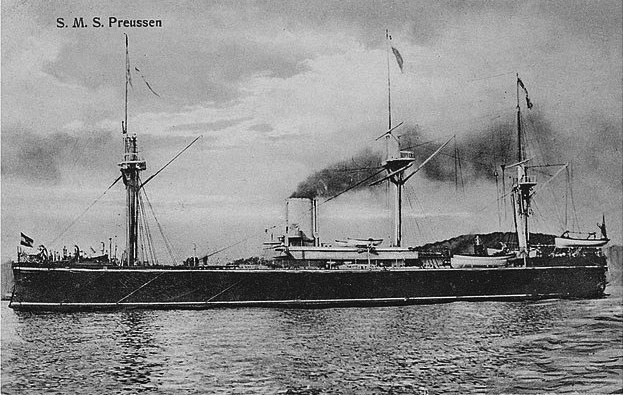
Preussen 1873, engraving
They departed for a new Mediterranean cruise on 29 May, but in the English Channel, König Wilhelm accidentally rammed Grosser Kurfürst and she did not immediately begin rescue operations, instead steered a wide circle before anchoring 800 m (2,600 ft) away as per regulations, then only picked up two men rescued previously by a British trawler. She escorted König Wilhelm to Portsmouth for repairs. Von Stosch ordered Batsch and staff to return to Germany on Preussen escorted by Falke, arriving in Wilhelmshaven, proceeded to Kiel on 10 June. Stosch criticized the captain’s lack of initiative in the rescue, but accepted his explanations of regulations and the risk of collision with all the small ships coming for the rescue. However, after four trials, Werner was forced into retirement.
The annual summer manoeuvres of 1878 were cancelled but Preussen trained naval cadets in the Baltic, then joined the Kaiser’s escort with Prinz Adalbert and on 9 November, was decommissioned for the winter.
On 5 May 1879 Preussen, Friedrich der Grosse, Kronprinz and Friedrich Carl departed for a training cruise in the Baltic Sea and off Norway with a stop in Russin and visit by Tsar Alexander III. Preussen towed a new floating dry dock from Swinemünde to Kiel. After winter decom. on 24 March 1880, Preussen was reduced to the reserve fleet, reactivated on 3 May under orders of Wilhelm von Wickede (former Austrian naval officer) as squadron commander, staying in the Baltic with stops at Wilhelmshaven and Cuxhaven. Same for the summer cruise in 1881 and they greeted a visit of the British reserve squadron led by HMS Warrior. She was in Dantzig during a meeting between Kaiser Wilhelm I and Alexander III. She was also active in 1882 (May-September) but was in reserve for 1883 with the Sachsen-class entering service.
She was modernized in 1883-1884 and early 1885, then again until 4 November 1888, but not recommissioned, instead in the Reserve Division, North Sea. In May 1889 she took part in the annual summer training program and was present for Kaiser Wilhelm II’s first visit to Great Britain in the II Division with Friedrich der Grosse, Kaiser and Deutschland under KAdm Friedrich von Hollmann. Their unit became the Training Squadron in 1889–1890 for a year-round ironclad force and she escorted the imperial yacht to the Mediterranean until the spring of 1890, back home on 22 April.
She escorted the Kaiser to Christiana, Norway and was at the ceremonial transfer of Helgoland to German control and took part in the largest manoeuvres with eight-ship squadron simulating a Russian fleet blockading Kiel. She made another tour in the Mediterranean under command of Konteradmiral Wilhelm Schröder. She had later an extensive overhaul until mid-May 1891, final tour with the II Division and decommissioned for good on 9 October, harbor guard ship in 1891, Reserve Division, North Sea, Wilhelmshaven and renamed Saturn on 12 November 1903, stricken on 21 May 1906, coal hulk for torpedo boats with holds for 5,000 t of coal, sold for BU on 27 June 1919. Figurehead is now on display in the Militärhistorisches Museum der Bundeswehr in Dresden, bow ornament at the Deutsches Museum in Munich.
 SMS Friedrich der Grosse
SMS Friedrich der Grosse
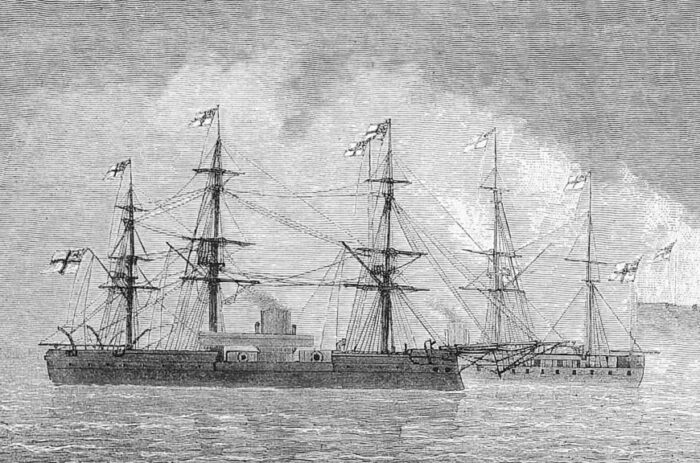
SMS Friedrich der Grosse was laid down after Grosser Kurfürst was launched at Kaiserliche Werft in 1871 and launched the last on 20 September 1874, but when completed on 22 November 1877 she was already nearing obsolescence. Her initial trials were in the Baltic Sea, interrupted in early January 1878 when transferred to Wilhelmshaven, in reserve with reduced crew under Korvettenkapitän Gustav Stempel for fitting out completion, and resuming trials until 19 May in Kiel.
Kapitän zur See Paul von Reibnitz took command when she joined the Ironclad Training Squadron for the annual summer fleet manoeuvres, under Konteradmiral Batsch. She however suffered from mechanical problems and ran aground off Nyborg, towed free, and left with a 60 m (200 ft) long gash in the outer bottom skin, and with chronic engine problems her cruise was cancelled, and she was decommissioned for repairs on 8 June but missed the cancelled summer 1878 manoeuvres.
She was back active in May 1879 under Konteradmiral Franz Kinderling. Furthermore, she trained in the Baltic with Preussen, Friedrich Carl and Kronprinz (see above). While Kiel on 23 June she lost one propeller and after repair, was decommissioned for the winter after a visit by the Kaiser.
Spring 1880 saw her recommissioned under Reibnitz and sqn. commander Wilhelm von Wickede. Training was limited to battle practice in the western Baltic and North Sea manoeuvres. Same for 1881 but under KzS Eduard von Knorr and hosting the British reserve squadron, a visit in Danzig, transfer to Wilhelmshaven, North Sea Naval Station.
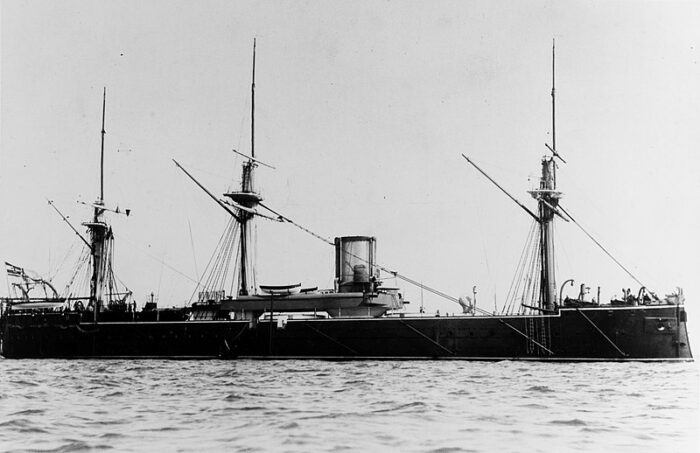
SMS Friedrich der Grosse in 1887
Same for 1882, summer cruise but reserve in the annual summer manoeuvres for 1883. Modernization and post-refit trials under KzS Bartholomäus von Werner, full reactivation on 6 April 1888, trials in the Jade Bay, squadron in Kiel for a tour of the Baltic with Kaiser Wilhelm II under KzS Ernst von Reiche and visits to St. Petersburg, Stockholm, and Copenhagen, meeting Alexander III and King Oscar II.
She was placed in the Reserve Division of the North Sea and guard ship in Wilhelmshaven under KzS Oscar Klausa and returned to Kiel on 4 May 1889 with the Training Squadron and Kaiser’s visit to Great Britain. She joined the II Division under Konteradmiral Friedrich von Hollmann for exercises in the North Sea, disbanded late August. Her overhaul was interrupted as whe was recalled in the new training squadron for 1889–1890. She sailed to Plymouth, escorted Wilhelm II’s imperial yacht to the Mediterranean, to Athens for the marriage of his sister Sophie to Prince Constantine. They stopped to Lisbon underway to Wilhelmshaven.
Overhaul was resumed and completed by 8 May. She joined the training sqn. in Kiel and escorted Wilhelm II to Christiania and ceremonies for the transfer of Helgoland. Back in Wilhelmshaven she was decommissioned on 22 September for another overhaul until 10 October 1891 under KzS Oscar von Schuckmann. She took part in winter 1891–1892 exercises in the North Sea and Baltic in January 1892, naval review held in Kiel (Alexander III visit on 7 June) and resumed exercises under Konteradmiral Hans von Koester for manoeuvres. Back to Wilhelmshaven she resumed her role as guard ship, Reserve Division and had another tour in 1893, cruise in the Baltic and 1893 manoeuvres with the II Division.
In 1894 she trained with the new Brandenburg in the II Division, now “Manoeuvre Squadron” under Konteradmiral Otto von Diederichs. While off Frisia, König Wilhelm ran aground and Friedrich der Grosse assisted, pulling her free. They sailed for Scotland via Oslo and Bergen and back to Kiel to recoal and summer exercises under KzS Wilhelm Büchsel (final commander) and training on the Baltic coast. She was decommissioned on 12 October 1894, inactive reserve, transferred to special purpose ships on 16 November 1896, harbour ship. Stricken 21 May 1906, coal hulk for torpedo boats and sold on 27 January 1919, BU at Rönnebeck in 1920.
Read More/Src
Books
Dodson, Aidan (2016). The Kaiser’s Battlefleet: German Capital Ships 1871–1918. Barnsley: Seaforth Publishing.
Gröner, Erich (1990). German Warships: 1815–1945. Vol. I: Major Surface Vessels. Annapolis: Naval Institute Press.
Lyon, Hugh (1979). “Germany”. Gardiner, Chesneau, Kolesnik, Conway’s All the World’s Fighting Ships 1860–1905.
Sondhaus, Lawrence (1997). Preparing for Weltpolitik: German Sea Power Before the Tirpitz Era. NIP
Links
on dreadnoughtproject.org
on en.wikipedia.org
on kbismarck.org
dailymail.co.uk/
on commons.wikimedia.org/

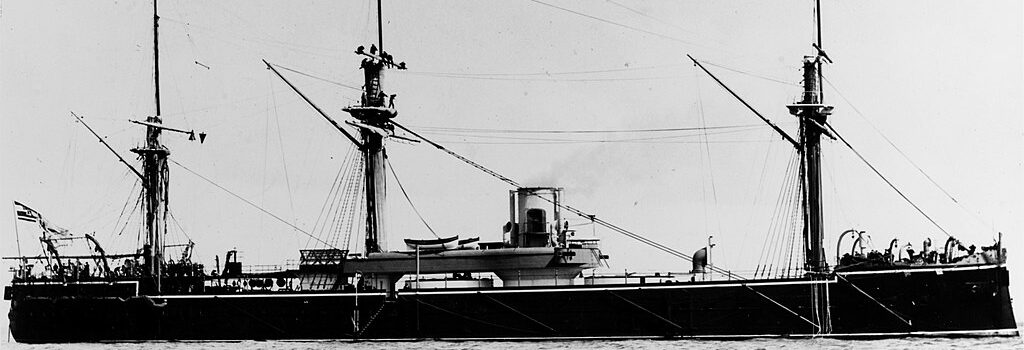


 Latest Facebook Entry -
Latest Facebook Entry -  X(Tweeter) Naval Encyclopedia's deck archive
X(Tweeter) Naval Encyclopedia's deck archive Instagram (@navalencyc)
Instagram (@navalencyc)





 French Navy
French Navy Royal Navy
Royal Navy Russian Navy
Russian Navy Armada Espanola
Armada Espanola Austrian Navy
Austrian Navy K.u.K. Kriegsmarine
K.u.K. Kriegsmarine Dansk Marine
Dansk Marine Nautiko Hellenon
Nautiko Hellenon Koninklije Marine 1870
Koninklije Marine 1870 Marinha do Brasil
Marinha do Brasil Osmanlı Donanması
Osmanlı Donanması Marina Do Peru
Marina Do Peru Marinha do Portugal
Marinha do Portugal Regia Marina 1870
Regia Marina 1870 Nihhon Kaigun 1870
Nihhon Kaigun 1870 Preußische Marine 1870
Preußische Marine 1870 Russkiy Flot 1870
Russkiy Flot 1870 Svenska marinen
Svenska marinen Søværnet
Søværnet Union Navy
Union Navy Confederate Navy
Confederate Navy Armada de Argentina
Armada de Argentina Imperial Chinese Navy
Imperial Chinese Navy Marinha do Portugal
Marinha do Portugal Mexico
Mexico Kaiserliche Marine
Kaiserliche Marine 1898 US Navy
1898 US Navy Sovietskiy Flot
Sovietskiy Flot Royal Canadian Navy
Royal Canadian Navy Royal Australian Navy
Royal Australian Navy RNZN Fleet
RNZN Fleet Chinese Navy 1937
Chinese Navy 1937 Kriegsmarine
Kriegsmarine Chilean Navy
Chilean Navy Danish Navy
Danish Navy Finnish Navy
Finnish Navy Hellenic Navy
Hellenic Navy Polish Navy
Polish Navy Romanian Navy
Romanian Navy Turkish Navy
Turkish Navy Royal Yugoslav Navy
Royal Yugoslav Navy Royal Thai Navy
Royal Thai Navy Minor Navies
Minor Navies Albania
Albania Austria
Austria Belgium
Belgium Columbia
Columbia Costa Rica
Costa Rica Cuba
Cuba Czechoslovakia
Czechoslovakia Dominican Republic
Dominican Republic Haiti
Haiti Hungary
Hungary Honduras
Honduras Estonia
Estonia Iceland
Iceland Eire
Eire Equador
Equador Iran
Iran Iraq
Iraq Latvia
Latvia Liberia
Liberia Lithuania
Lithuania Mandchukuo
Mandchukuo Morocco
Morocco Nicaragua
Nicaragua Persia
Persia San Salvador
San Salvador Sarawak
Sarawak Uruguay
Uruguay Venezuela
Venezuela Zanzibar
Zanzibar Warsaw Pact Navies
Warsaw Pact Navies Bulgaria
Bulgaria Hungary
Hungary

 Bundesmarine
Bundesmarine Dutch Navy
Dutch Navy Hellenic Navy
Hellenic Navy Marina Militare
Marina Militare Yugoslav Navy
Yugoslav Navy Chinese Navy
Chinese Navy Indian Navy
Indian Navy Indonesian Navy
Indonesian Navy JMSDF
JMSDF North Korean Navy
North Korean Navy Pakistani Navy
Pakistani Navy Philippines Navy
Philippines Navy ROKN
ROKN Rep. of Singapore Navy
Rep. of Singapore Navy Taiwanese Navy
Taiwanese Navy IDF Navy
IDF Navy Saudi Navy
Saudi Navy Royal New Zealand Navy
Royal New Zealand Navy Egyptian Navy
Egyptian Navy South African Navy
South African Navy






























 Ukrainian Navy
Ukrainian Navy dbodesign
dbodesign